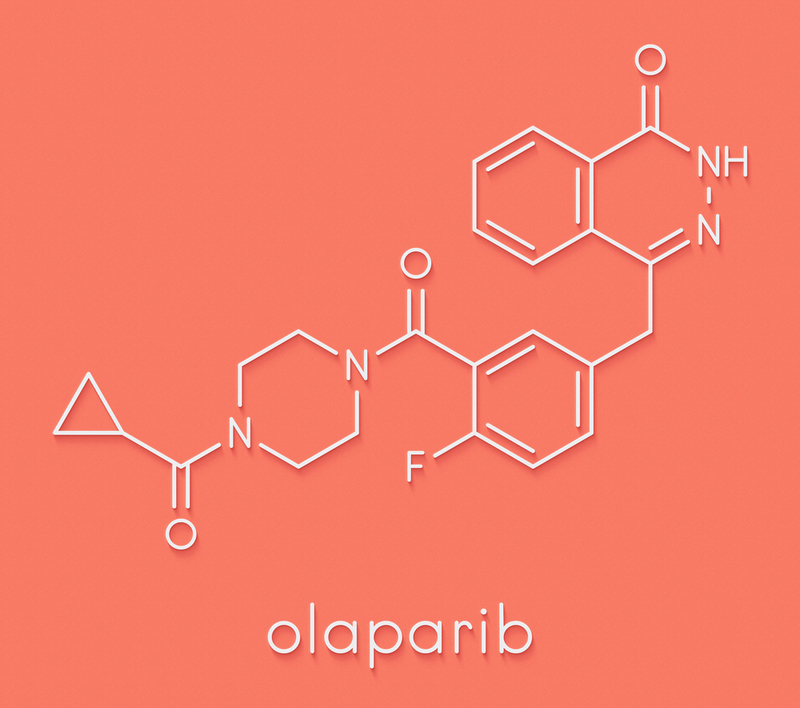Olaparib maintenance extends progression-free survival by estimated 3 years in advanced ovarian cancer
ESMO 2018 Press Release Oct 23, 2018
Two-year maintenance therapy with olaparib, a PARP (poly ADP ribose polymerase) inhibitor, olaparib, led to a substantial, unprecedented improvement in progression-free survival (PFS) in newly diagnosed patients with advanced ovarian cancer and a BRCA1 or 2 mutation, results from the phase 3 SOLO-1 trial show.

“The median PFS for patients who received placebo was only 13.8 months while the median PFS for those who received olaparib was not reached but looks to be approximately three years longer than the placebo group [HR was 0.30; 95% CI: 0.23, 0.41; p<0.0001],” reported Dr Kathleen Moore, Associate Professor at the Stephenson Cancer Center, University of Oklahoma, US, presenting the results at ESMO 2018 Congress.
“While it is too early to say whether we have impacted the fraction of women who could be cured with their front-line therapy, the fact that it is estimated that over 50% of women on the olaparib arm were still progression-free at four years as compared to only 11% for placebo speaks to this hope,” she remarked. “The results of SOLO-1 herald a new era in treatment for women diagnosed with advanced ovarian cancer who carry a BRCA mutation [a mutation in either of the BRCA1 and BRCA2 genes]. This study demonstrates an outstanding improvement in PFS over placebo which is maintained even after the olaparib is stopped at two years,” added Moore.
SOLO-1 is the first, double-blind, randomised, prospective phase 3 evaluating front-line olaparib maintenance therapy after platinum-based chemotherapy in newly diagnosed advanced ovarian cancer (FIGO stage III–IV) with a BRCA mutation. “It provides the first large dataset of prospectively collected outcomes for this population of women,” said Moore.
A total of 391 patients with high grade serous or endometrioid ovarian cancer who were in clinical complete or partial response after chemotherapy upon entering the study, were randomised, 2:1, to olaparib tablets 300 mg bd (n=260) or placebo (n=131) for two years. The primary endpoint was investigator-assessed PFS from randomisation. Secondary outcomes included PFS2, which was time from randomisation to the second progression event a patient might experience; overall survival; and quality of life. Median follow-up was 41 months.
PFS2 remained significantly improved among patients who had received olaparib maintenance with a median PFS2 of 41.9 months for placebo versus median not reached for the olaparib group (HR: 0.50; 95%CI: 0.35, 0.72; p=0.0002).
The most common grade ≥3 toxicities with olaparib were anaemia (22%) and neutropenia (8%). There was no clinically relevant change in quality of life between groups and dosing was well tolerated with only 12% of patients discontinuing olaparib due to toxicity and not disease progression. Furthermore, there was no detriment to quality of life.
“These are outstanding results in a worsening disease setting. Not only was olaparib efficacious but it was also shown to be well tolerated,” said Prof Isabelle Ray-Coquard, from Université Claude Bernard Lyon Est, Lyon, France, commenting on the results for ESMO. “The findings promise to change practice in this subgroup of patients with a BRCA mutation.”
“Now, two questions remain. Can we expand this benefit to all high-grade serous carcinomas? Looking at existing results in relapse with PARP inhibitor maintenance in all comers, we can anticipate excellent results for all patients with high grade serous or endometrioid ovarian carcinoma,” added Ray-Coquard. “Also, what is the best maintenance therapy?
Standard first-line therapy in many countries is chemotherapy plus bevacizumab maintenance for the majority of advanced disease, but the question remains whether maintenance with olaparib alone, or in combination with bevacizumab is preferable. The PAOLA 1 trial will provide some information, and will probably be available next year.”
-
Exclusive Write-ups & Webinars by KOLs
-
Daily Quiz by specialty
-
Paid Market Research Surveys
-
Case discussions, News & Journals' summaries